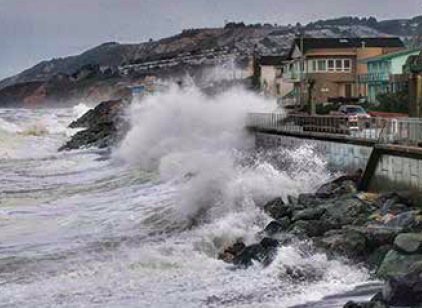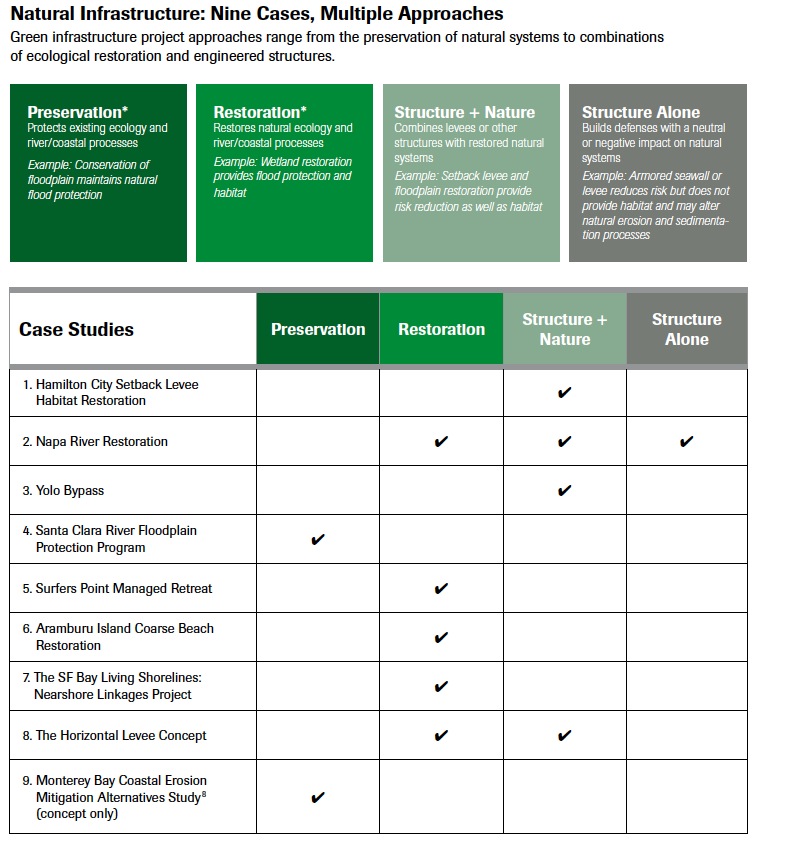THE NATURE CONSERVANCY
 Over the past two centuries, efforts to control flooding have
Over the past two centuries, efforts to control flooding have
transformed California’s natural landscape. Rivers have been
dammed and constrained by levees, wetlands have been drained
and shorelines have been fortified against erosion. These projects
opened land to urban and agricultural development but at a
huge and ongoing cost to fish, migratory birds and other wildlife
throughout the state. Roughly 10 percent of California’s historic
wetlands remain, nearly all major streams have been altered
dramatically and more than 100 miles of the state’s coastline have
been armored with rock and concrete.
Despite these measures—implemented at great
expense—significant risks to people and property
remain. Coastal erosion threatens homes from San
Clemente to Santa Barbara to Pacifica. Along the
shores of San Francisco Bay, at least $29 billion in
property, including major business centers, is
currently at risk from a 100-year flood.
Climate change is expected to drive a combination
of extreme weather and sea level rise that will
increase the risk of flooding in California. The
Intergovernmental Panel on Climate Change, the
leading international body for the assessment of
climate change, anticipates a significant increase in
heavy precipitation events, translating to increased
flood risk in many watersheds. The state Ocean
Protection Council projects that sea level will rise
five to 25 inches by 2050, and 17 to 66 inches
by 2100.
Already, the state’s communities are considering
how to respond to the growing risks. Much is at
stake, as substantial resources likely will be devoted
to protecting communities. For example, Louisiana
recently adopted a $50 billion plan to prepare for
rising sea levels and future storms.
As California considers how to adapt to a changing
climate, planners often focus on defensive infrastructure
with a negative habitat impact: bigger
levees, rock walls to protect coastlines or even giant
sea gates.
But California can follow a different path. With
natural or “green” infrastructure that leverages
natural processes to reduce risk to human lives,
property and businesses, the state can build resilience
to the coming changes while restoring natural
habitats instead of degrading them.
“Green” or “natural” infrastructure can include a range of strategies. Some projects focus on preserving existing natural systems, while others are highly engineered, combining green techniques with more traditional “gray” approaches.
This report evaluates nine green infrastructure case studies in California. Each improves flood or coastal protection, provides habitat and preserves or restores the natural dynamics between water and land. We review the available data on the costs and benefits of each case and, where possible, compare this information with the costs and benefits of a gray alternative at the same site.
Download full version (PDF): Reducing Climate Risks with Natural Infrastructure
About the Nature Conservancy
www.nature.org
The Nature Conservancy is the leading conservation organization working around the world to protect ecologically important lands and waters for nature and people.
Tags: CA, California, Nature Conservancy







 RSS Feed
RSS Feed